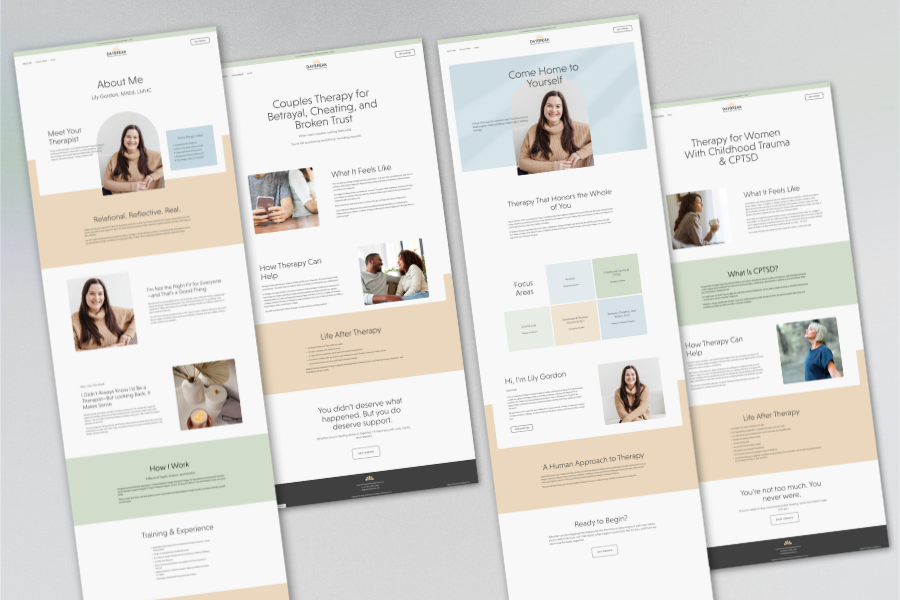How to Use ChatGPT to Write Your Therapy Website Copy (With Prompts!)
How to Use ChatGPT to Write Your Therapy Website Copy
Quick Answer for Skimmers (and Search Engines):
ChatGPT can be a powerful tool to help you write therapy website copy—if you treat it like a thoughtful co-writer, not an autopilot. It’s your brainstorming partner, clarity coach, and creative spark—not the whole solution.
What to Expect in This Post:
You'll discover how to use ChatGPT in ways that land your voice—not an AI’s—by pairing it with smart prompts, editing for emotional depth, and keeping your clients (not algorithms) in mind. Plus, I’ve included ready-to-use prompt templates to help you get started.
I. Why Use ChatGPT to Write Your Website Copy?
Writing about yourself is hard. You know the work you do is important, but when you sit down to describe it, your mind goes blank. You might wonder what to say, how much to share, or how to explain your services in a way that actually resonates with potential clients. That’s where ChatGPT comes in.
When used thoughtfully, ChatGPT becomes your brainstorming partner, writing assistant, and clarity coach all in one. It helps you:
Get unstuck and avoid the dreaded blank page
Say what you mean in a warm, professional voice
Organize your thoughts clearly and effectively
Save time and energy
Stay in control of your message
Optimize your copy for search engines
If you’ve purchased one of my templates, you’re already set up for success. Your site is beautifully designed and strategically structured—all you need to do is plug in copy that reflects your practice. This guide will show you exactly how to use ChatGPT to generate that copy section-by-section, so you can launch your site with confidence.
If you haven’t purchased one of my templates, you can still follow the structure by viewing one of them in the template shop. Here’s quick access to the Radiant Roots website demo.
II. Tips for Getting the Best Results with ChatGPT
Before we dive into the page prompts, here are a few key things to know about working with ChatGPT effectively:
Be Specific. The more details you give, the better your results. Include your niche, tone, location, and anything that makes your practice unique.
Feed It Samples. If you have writing that sounds like you (email replies, old bios, blog posts, etc.), paste it in! ChatGPT can mimic your style when it has something to reference.
Talk to It Casually. No need to write perfect prompts. Just ask questions or give directions like you would to a human assistant.
Don’t Accept the First Draft Blindly. If something feels off, ask ChatGPT to try again with a different tone, simplify it, or use different language.
Work One Section at a Time. Trying to write an entire website in one go is overwhelming. Break it down page-by-page (or even section-by-section) and copy/paste into your template as you go.
Use Your Template Structure. My templates are built to flow naturally and guide your visitors through your site. The prompts in this guide are matched to those structures.
III. Start Here: Your Kickoff Prompt
Before diving into page-specific prompts, start by helping ChatGPT understand your practice. Use this prompt to kick things off:
Prompt:
I’m a therapist filling out my new website template. Please help me write copy for my Home, About, and Services pages. Here is some information about my practice:
My ideal client(s): [describe your ideal client]
The types of therapy or services I offer: [describe your offerings]
My values, tone, and personality as a therapist: [share your values, tone, and the unique characteristics you bring to your work]
My approach to therapy: [your theoretical orientation(s), and if there is a meaningful reason you chose them, share that too]
Whether I offer telehealth, in-person, or both: [or any other modality not described above]
My location (city + state) for SEO: [if you are telehealth only and licensed in multiple states, don’t bother with city]
Please ask as many questions as needed to write copy in my voice.
ChatGPT may respond with a series of interview-style questions. Once you answer those, you can move on to writing individual pages using the prompts below.
IV. Plug-and-Play Prompts for Each Page
Each set of prompts below is tailored to the structure of your template. Simply copy, paste, and customize the parts in brackets.
Home Page
Template structure includes:
Hero section (Headline + Subheadline with location + session type)
Value proposition
Intro to therapist
Services/specializations preview
Optional additional service section
Call to action
Prompt:
Write the copy for my Home page using the structure below. Make the tone match my earlier answers. Keep it conversational, warm, reassuring, clear, and concise. Include my location and whether I offer telehealth or in-person therapy.
Hero section:
– Write a short, compelling headline that reflects what I help with.
– Write a subheadline that includes my city/state and whether I offer virtual, in-person, or hybrid sessions.Value Proposition:
– One short paragraph that connects with the reader’s struggles and introduces how I can help.Meet the Therapist:
– One short paragraph introducing who I am and the kind of clients I love working with.Services/Specializations:
– Write 2–3 short blurbs (2–3 sentences each) introducing each service or specialization I offer.Optional:
– Add a short paragraph highlighting any additional services (e.g., workshops, supervision, assessments).Call to Action:
– Write a friendly, inviting CTA encouraging visitors to go to the Contact page.
About Page
Template structure includes:
Hero section
2–3 content sections (intro, values/philosophy, approach)
Bullet list of training/credentials
Call to action
Prompt:
First, ask me questions that will help you write my About page, including:
How I describe my values and philosophy as a therapist
What makes my approach or services unique
My training, credentials, and relevant experience
Then, write the copy for my About page using this structure and the tone I shared earlier:
Hero section:
– Write a welcoming page title and subheadline with my location and session type.Section 1: Introduction
– A paragraph welcoming the reader and describing the kind of clients I work with.Section 2: Values and Philosophy
– A paragraph about my values and philosophy as a therapist.Section 3: How I Work
– A paragraph explaining my approach to therapy and what makes me unique.Credentials + Training:
– Create a bullet list of licenses, degrees, certifications, and notable trainings I’ve completed.Call to Action:
– End with a short CTA inviting readers to reach out via the Contact page.
Services / Specialization Pages
Template structure includes:
Hero section (title + subheadline with location and session type)
Three body sections (1) Client experience, 2) Therapist approach, 3) Benefits/outcomes)
Call to action
These prompts work for any kind of focus: client type, issue, modality, benefit, or service type.
Prompt:
Write the copy for a Services/Specialization page on [insert topic or service here]. The structure should follow these sections:
Hero section:
– Write a page title that reflects the focus area (e.g., Healing from Anxiety, Therapy for New Moms, EFT for Couples).
– Write a subheadline that includes my location (city, state) and whether I offer virtual, in-person, or both.Section 1: Client Experience
– Write a paragraph that reflects what clients in this group or issue are going through.Section 2: My Approach
– Describe how I work with this issue or population. Include any modalities I use and how sessions typically feel.Section 3: Benefits/What Clients Can Expect
– Describe the outcomes clients can expect or the experience of therapy with me over time.Call to Action:
– Invite readers to take the next step and visit the Contact or Get Started page to reach out.
V. Wrapping Up: Let ChatGPT Help, But Keep It You
ChatGPT is a tool—a smart one! But you still get to be the final voice. Use it to shape and organize your thoughts, but feel free to revise, delete, or rewrite anything that doesn’t feel like you.
Keep these reminders in mind:
Clarity beats cleverness. Say what you mean.
You don’t have to sound like every other therapist. Sound like you.
Progress > perfection. Your site doesn’t have to be flawless to be effective.
Your website is your handshake with the world. With your template and these prompts, you're well on your way to creating a site that reflects your values, attracts your people, and supports your practice.
Ready to launch your website?
Shop the High Five Design Co. Template Shop for therapist-friendly templates designed to help you connect with your ideal clients—effortlessly.
Pin it!
Some of My Favorite Private Practice Tools
Resources and Referral Links


































